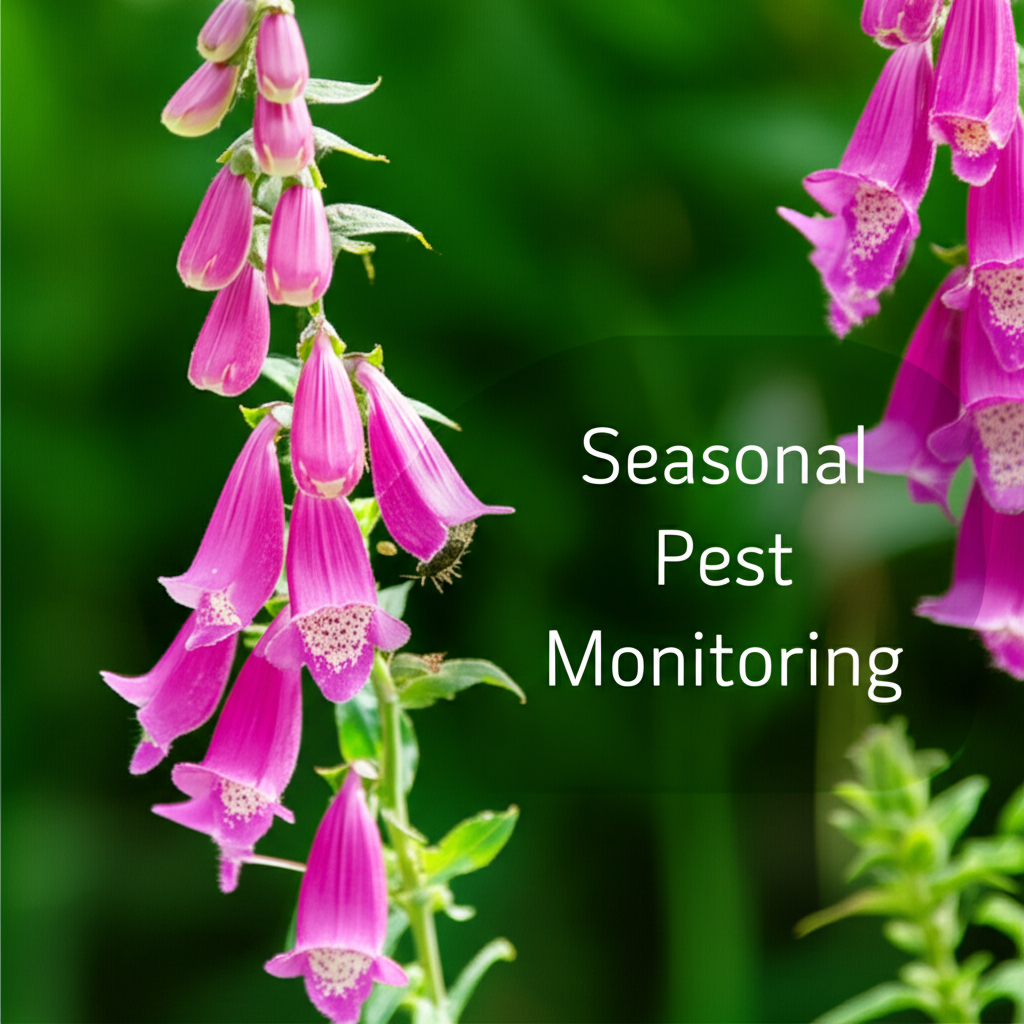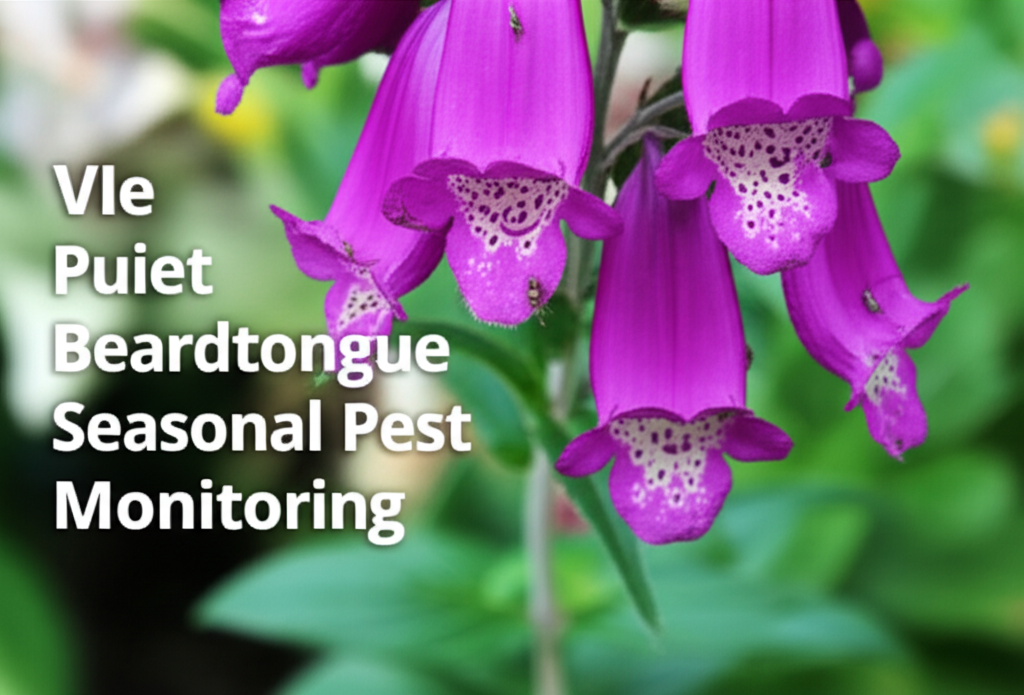Understanding Foxglove Beardtongue and Its Vulnerabilities
Foxglove Beardtongue, scientifically known as Penstemon digitalis, is a prized native perennial celebrated for its striking spikes of tubular, often white or pale lavender flowers. These blooms are not only a visual delight but also a vital nectar source for pollinators like bees and butterflies, making it a cornerstone of biodiverse gardens and natural landscapes. However, like any plant, Foxglove Beardtongue is susceptible to various pests that can compromise its health, vigor, and ornamental appeal. Proactive and seasonal pest monitoring is crucial for maintaining healthy Penstemon digitalis populations and ensuring their continued contribution to the ecosystem.
Understanding the life cycles of both the plant and its potential adversaries is the first step in effective pest management. Foxglove Beardtongue typically emerges in early spring, with rapid vegetative growth followed by a spectacular bloom period from late spring through summer. Its resilience to drought once established is notable, but young plants and those under stress are more vulnerable.
Common Pests Affecting Foxglove Beardtongue
Several insect species commonly target Foxglove Beardtongue. Identifying these pests is key to implementing the correct control measures.
- Aphids: Small, soft-bodied insects that cluster on new growth, stems, and flower buds. They feed on plant sap, causing distorted growth and weakening the plant.
- Spider Mites: Tiny arachnids that thrive in hot, dry conditions. They spin fine webbing on the undersides of leaves and feed on plant fluids, leading to stippling, yellowing, and eventual leaf drop.
- Slugs and Snails: Mollusks that are most active at night and in damp conditions. They chew irregular holes in leaves and can damage flower buds and stems.
- Leafminers: The larvae of various flies that burrow within plant leaves, creating characteristic winding tunnels. This feeding can reduce the plant’s ability to photosynthesize.
- Thrips: Tiny, slender insects that feed on flowers and young leaves, causing silvery or bronzed discoloration and distorted growth.
- Caterpillars: Larvae of moths and butterflies, which can vary in appearance and feeding habits. Some chew large holes in leaves, while others may skeletonize them.
Seasonal Monitoring: A Proactive Approach

Effective pest management is not a reactive measure; it’s a continuous, seasonal process. By observing your Foxglove Beardtongue plants at different times of the year, you can detect early signs of infestation and intervene before significant damage occurs.
Early Spring (March-April): Emergence and Initial Assessment
As the weather warms and Penstemon digitalis begins to emerge from dormancy, this is an ideal time for an initial inspection. Look for any signs of overwintering pests or damage from the previous season.
- What to look for: Inspect emerging shoots for any discoloration, wilting, or presence of small insects. Check the soil surface for slugs or snail egg masses. Clear away any plant debris from around the base of the plants, as this can harbor overwintering pests.
- Focus: Early detection of aphids on new growth, and evidence of slug/snail activity.
Late Spring (May-June): Vegetative Growth and Bud Formation
This period is critical as the plant enters its active growth phase and begins to form flower buds. Pests are also actively reproducing during this time.
- What to look for: Examine the undersides of leaves for spider mites and their webbing. Inspect new growth and bud clusters for aphids and thrips. Look for small holes in leaves that might indicate early slug or snail feeding or leafminer activity.
- Focus: Identifying aphid colonies, spider mite infestations, and early signs of leaf damage.
Summer (July-August): Flowering and Peak Activity
During the peak bloom period, Foxglove Beardtongue is a magnet for pollinators, but it can also attract pests that feed on flowers and developing seeds.
- What to look for: Continue to monitor for aphids and spider mites, which can thrive in warm weather. Inspect flower spikes for signs of thrips, which can damage the blooms. Look for caterpillars feeding on leaves or flower buds.
- Focus: Maintaining vigilance for continued aphid and spider mite presence, and identifying any caterpillar damage.
Fall (September-October): Post-Bloom and Preparation for Dormancy
After flowering, the plant may still be susceptible to certain pests as it prepares for winter. This is also a good time to assess the overall health of your plants and plan for the following season.
- What to look for: Check for any lingering spider mite activity. Remove any dead or diseased foliage to prevent the spread of pathogens and to reduce overwintering sites for pests.
- Focus: Final checks for pest activity and preparing the plants for winter.
Key Facts and Comparison of Common Pests
Understanding the distinct characteristics and feeding habits of common pests is essential for accurate identification and targeted management.
| Pest | Appearance | Feeding Habit | Typical Damage | Best Monitoring Time |
|---|---|---|---|---|
| Aphids | Small, soft-bodied (green, black, brown, or pink), often found in clusters. | Suck sap from new growth, stems, and buds. | Curled, distorted leaves; weakened growth; sooty mold (from honeydew). | Spring, Summer |
| Spider Mites | Tiny, nearly invisible to the naked eye, often red or brown. Fine webbing on undersides of leaves. | Pierce leaf cells and suck out sap. | Stippled or bronzed leaves, yellowing, leaf drop. | Hot, dry Summer conditions |
| Slugs and Snails | Slime trails, soft-bodied, varied sizes and colors. | Chew irregular holes in leaves and flowers. | Ragged holes in foliage, damaged buds. | Cool, damp evenings/mornings, especially Spring/Fall. |
| Leafminers | Larvae are small, white or yellow grubs inside leaves. | Tunnel within leaf tissue, feeding on the interior. | Serpentine or blotchy mines on leaves. | Spring, Summer |
| Thrips | Tiny, slender insects, often black or brown, with fringed wings. | Scrape leaf and flower surfaces, feeding on sap. | Silvery or bronzed discoloration on leaves and flowers; distorted growth. | Summer |
Integrated Pest Management (IPM) Strategies for Foxglove Beardtongue
An Integrated Pest Management (IPM) approach emphasizes a combination of cultural, biological, and chemical controls, used judiciously to minimize environmental impact and promote plant health.
Cultural Controls
These are preventative measures that focus on creating an environment less favorable to pests.
- Healthy Plant Practices: Ensure plants are watered properly (avoiding over or under-watering) and fertilized appropriately. Stressed plants are more susceptible to pests.
- Sanitation: Remove and destroy infested plant material, fallen leaves, and debris, especially in the fall, to eliminate overwintering sites for pests and diseases.
- Proper Spacing: Adequate spacing between plants promotes good air circulation, which can deter fungal diseases and make it harder for pests to spread.
- Weed Control: Weeds can harbor pests and diseases, so maintain a weed-free garden bed.
Biological Controls
These methods utilize natural predators and beneficial insects to manage pest populations.
- Attracting Beneficials: Plant a diversity of flowering plants that provide nectar and pollen for natural enemies of common garden pests, such as ladybugs, lacewings, and predatory mites.
- Avoid Broad-Spectrum Pesticides: When pest control is necessary, opt for targeted treatments that spare beneficial insects.
Mechanical and Physical Controls
These are hands-on methods to remove or deter pests.
- Handpicking: For larger pests like caterpillars or slugs, handpicking them off the plants and dropping them into soapy water is effective.
- Water Spray: A strong blast of water can dislodge aphids from new growth.
- Barriers: Copper tape or diatomaceous earth can be used to deter slugs and snails.
Chemical Controls (Use as a Last Resort)
When other methods fail, targeted chemical interventions may be necessary. Always read and follow label instructions carefully.
- Insecticidal Soap: Effective against soft-bodied insects like aphids and spider mites. It works by disrupting their cell membranes.
- Horticultural Oils (Neem Oil): These oils can suffocate insects and disrupt their life cycles. Neem oil also has fungicidal properties.
- Biological Insecticides (Bt): Bacillus thuringiensis is a bacterium that is toxic to caterpillars when ingested.
Steps for Effective Seasonal Monitoring and Action
A systematic approach to monitoring will yield the best results.
| Phase | Key Actions | Pros | Cons |
|---|---|---|---|
| Early Spring | Inspect emerging shoots, clear debris, check soil surface. | Early detection of overwintering pests. Proactive cleanup prevents future issues. | Requires careful observation of small emerging plants. |
| Late Spring | Examine leaf undersides, new growth, bud clusters. | Identify active infestations before significant damage. Allows for timely intervention. | Pests can be small and difficult to spot. |
| Summer | Continue checking flowers and foliage for pests. | Monitor for heat-loving pests and damage to blooms. | Hot weather can make monitoring uncomfortable. |
| Fall | Final checks, remove dead foliage. | Reduces overwintering pest populations and disease spread. Prepares plants for winter. | Requires diligent cleanup to be most effective. |
| General Monitoring | Regular visual inspections, plant health assessment. | Builds knowledge of plant and pest behavior. Leads to more effective, less intensive management. | Time commitment is necessary. |
Developing a Pest Monitoring Log
Maintaining a simple log can be incredibly beneficial. Record the date, the specific Penstemon digitalis plant or section being observed, any pests or damage found, and the actions taken. This record can help you identify patterns in pest activity and the effectiveness of different management strategies over time.
When to Intervene: Thresholds and Decision Making
It’s important to remember that a few pests on a plant are not necessarily a cause for alarm. Many plants can tolerate a low level of pest activity without significant harm. Intervention is generally warranted when:
- Pest populations are high and visibly damaging the plant.
- The plant is young or otherwise stressed and less able to recover.
- The aesthetic value of the plant is significantly compromised.
Conclusion: Cultivating a Resilient Garden
Seasonal pest monitoring for Foxglove Beardtongue is a fundamental practice for any gardener aiming to cultivate healthy, thriving plants. By understanding the common pests, committing to regular observations throughout the growing season, and employing a thoughtful integrated pest management approach, you can effectively protect your Penstemon digitalis. This proactive strategy not only safeguards your plants but also contributes to a more balanced and resilient garden ecosystem, ensuring that these beautiful native perennials continue to grace our landscapes and support vital pollinator populations. Remember, knowledge and vigilance are your most powerful tools in the ongoing effort to keep your Foxglove Beardtongue healthy and vibrant.


